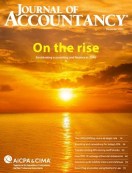- newsletter
- Cpa Insider

What the future of medical diagnostics could mean for CPAs
Biomarkers may allow identification of diseases before patients even show symptoms.
Please note: This item is from our archives and was published in 2018. It is provided for historical reference. The content may be out of date and links may no longer function.
Related
FIRE-d up for early retirement
Advising chronically or terminally ill clients
Hacking retirement: Technology to spur saving
Currently, clients are only roughly able to estimate their chances of being diagnosed with a chronic illness based on factors such as their age, weight, fitness level, and family history. In the near future, that could change. Advances in medicine may provide us with the ability to predict whether an individual is likely to suffer from costly diseases such as Alzheimer’s dementia, amyotrophic lateral sclerosis (ALS or Lou Gehrig’s disease), Parkinson’s disease, and certain types of stroke and cancer. These advances in diagnostics could have big implications for CPAs.
Scientists are developing ways to identify biological markers, or biomarkers: changes that indicate someone is in the very early stages of an illness. For example, Alzheimer’s once could only be identified in the late stages of the disease, when a patient was already significantly cognitively impaired. Now, Alzheimer’s can be diagnosed when a patient is exhibiting only mild cognitive impairment through brain imaging or the identification of abnormal proteins in cerebrospinal fluid. By testing for biomarkers, doctors can determine whether a patient suffering from mild cognitive impairment will develop Alzheimer’s. In 2011 the National Institute on Aging and the Alzheimer’s Association published criteria for the diagnosis of Alzheimer’s based on biomarkers.
Research into biomarkers is still in its early stages. Clinical biomarker tests for most diseases are not available to patients yet. However, testing for biomarkers is still a trend CPAs will want to keep their eyes on. Early diagnosis of serious illness could prove beneficial for financial planning purposes, and there may be medical, emotional, and social benefits for patients and their families.
For example, early diagnosis could influence the retirement planning process. As diagnostics advance, more clients will have more information to include as part of the retirement plan. With this knowledge, CPAs may be able to better estimate health care costs in retirement.
The planning benefits of earlier diagnosis might include the ability to:
- Create a preliminary care budget years earlier, including a review of housing needs and potential sources of payment for care. For example, a client receiving an early diagnosis of Alzheimer’s disease could decide to move with his or her spouse to be closer to the couple’s grown children, who may help with caregiving when needed.
- Update legal documents and estate plans before any symptoms or cognitive problems appear.
- Reassess the client’s insurance coverage — especially health, life, disability, and long-term care. For example, an early diagnosis could help clients make more informed decisions about whether to let certain insurance policies lapse. It could also help guide decisions about accessing policy benefits that can pay for care.
- Create an end-of-life plan as needed, knowing the likely course of the disease.
- Review the family budget to account for a change in employment benefits, including early retirement considerations, veteran’s benefits, and insurance.
- Plan for the survivor if the illness is terminal. The diagnosed client and the caregiving financial partner will both have concerns about what financial resources will remain for the survivor after the ill client dies.
- Plan for the unexpected death of the caregiver. Planning is often so focused on the ill client that no thought is given to the caregiver’s death coming first. Clients need to know who would replace the caregiver, especially if the caregiver is elderly, and whether there will be money to pay for a professional caregiver if the unpaid caregiver dies first.
Testing for biomarkers may create ethical quandaries as well. Issues CPAs will need to contemplate include whether personalized medical information should be used to inform planning, when it will become reliable enough to incorporate into a plan, and how to use and incorporate the new information. Even more important will be establishing ethical boundaries around the request for and use of such data. Will CPAs one day be obligated to ask clients if they have been tested for biomarkers and what the results of the tests indicated? If the client refuses to take a test or share results, will the CPA be obligated to include a disclaimer in the retirement plan projections? Will such refusals taint the accuracy of the retirement plan?
This kind of testing brings both promise and uncertainty. CPAs would do well to stay apprised of developments in this changing field.
James Sullivan, CPA/PFS, is a financial planner in Wheaton, Ill. He specializes in working with clients, and the families of clients, suffering from chronic illness. To comment on this article or to suggest an idea for another article, contact senior editor Courtney Vien at Courtney.Vien@aicpa-cima.com.



















